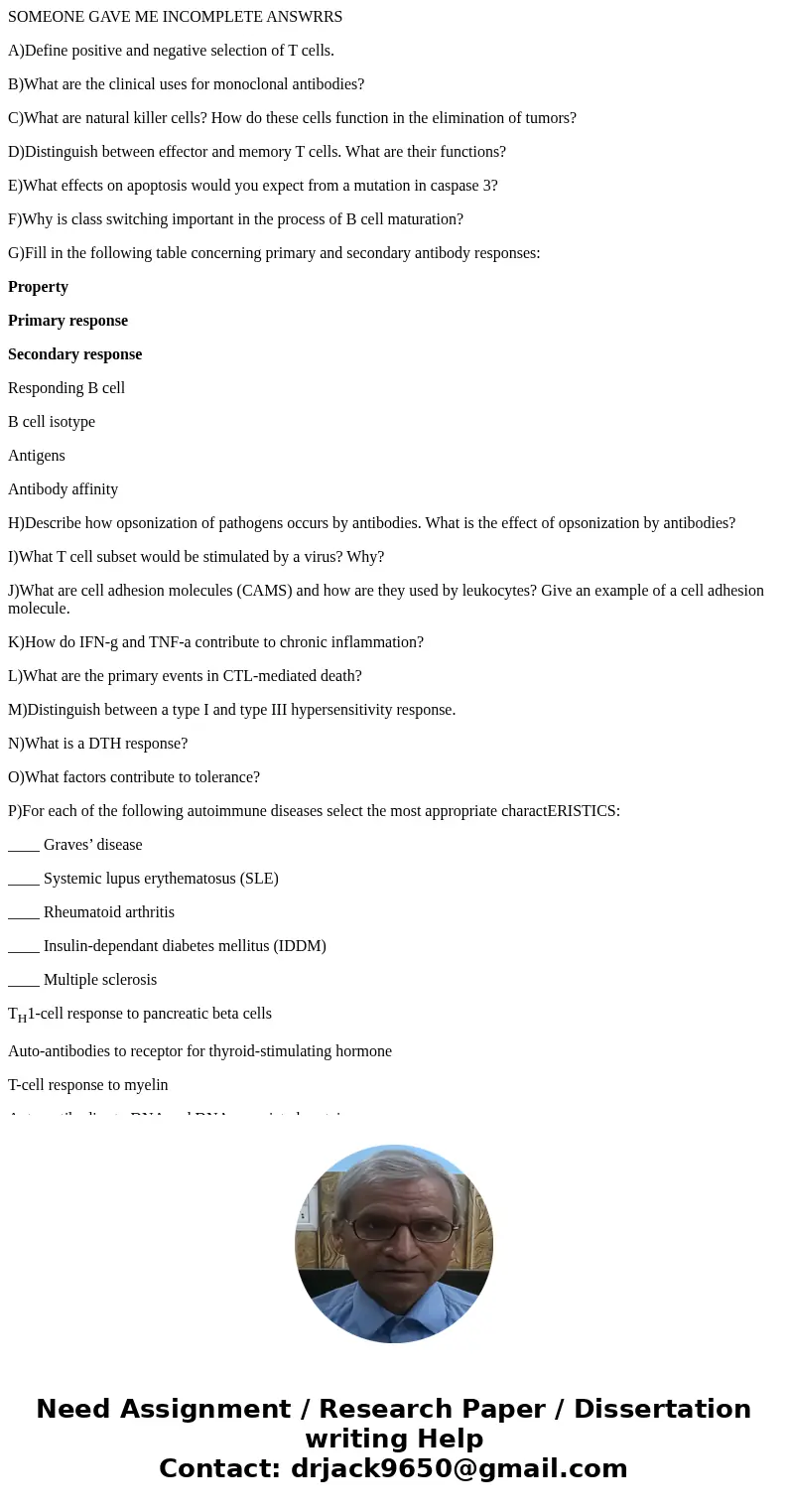SOMEONE GAVE ME INCOMPLETE ANSWRRS ADefine positive and nega
SOMEONE GAVE ME INCOMPLETE ANSWRRS
A)Define positive and negative selection of T cells.
B)What are the clinical uses for monoclonal antibodies?
C)What are natural killer cells? How do these cells function in the elimination of tumors?
D)Distinguish between effector and memory T cells. What are their functions?
E)What effects on apoptosis would you expect from a mutation in caspase 3?
F)Why is class switching important in the process of B cell maturation?
G)Fill in the following table concerning primary and secondary antibody responses:
Property
Primary response
Secondary response
Responding B cell
B cell isotype
Antigens
Antibody affinity
H)Describe how opsonization of pathogens occurs by antibodies. What is the effect of opsonization by antibodies?
I)What T cell subset would be stimulated by a virus? Why?
J)What are cell adhesion molecules (CAMS) and how are they used by leukocytes? Give an example of a cell adhesion molecule.
K)How do IFN-g and TNF-a contribute to chronic inflammation?
L)What are the primary events in CTL-mediated death?
M)Distinguish between a type I and type III hypersensitivity response.
N)What is a DTH response?
O)What factors contribute to tolerance?
P)For each of the following autoimmune diseases select the most appropriate charactERISTICS:
____ Graves’ disease
____ Systemic lupus erythematosus (SLE)
____ Rheumatoid arthritis
____ Insulin-dependant diabetes mellitus (IDDM)
____ Multiple sclerosis
TH1-cell response to pancreatic beta cells
Auto-antibodies to receptor for thyroid-stimulating hormone
T-cell response to myelin
Auto-antibodies to DNA and DNA-associated protein
Auto-antibody to IgG
Q)How does antigenic variation help organisms evade the immune response?
R)What are the risks associated with inactivated whole-cell vaccines?
S)What is the purpose of the CTLA-4Ig in inducing anergy and preventing graft rejection?
| Property | Primary response | Secondary response |
| Responding B cell | ||
| B cell isotype | ||
| Antigens | ||
| Antibody affinity |
Solution
A) Define positive and negative selection of T cells.
Negative selection is the process by which T cells are screened so that those with a high affinity for binding to self antigens are destroyed. Positive selection is the process by which T cells are screened so that only those capable of binding to MHC are kept alive. .
B) What are the clinical uses for monoclonal antibodies?
1. Antibodies can also be used to purify their target compounds from mixtures, using the method of immunoprecipitation.
2. Therapeutic monoclonal antibodies act through multiple mechanisms, such as blocking of targeted molecule functions, inducing apoptosis in cells which express the target, or by modulating signalling pathways.
C) What are natural killer cells? How do these cells function in the elimination of tumors?
Natural killer cells (NK cells) are large, granular lymphocytes that do not express the set of surface markers typical of B or T cells. Resting B and T lymphocytes are small, motile, nonphagocytic cells,which cannot be distinguished morphologically.
Upon release in close proximity to a cell slated for killing, perforin forms pores in thecell membrane of the target cell, creating an aqueous channel through which the granzymes and associated molecules can enter, inducing either apoptosis or osmoticcell lysis.
D)Distinguish between effector and memory T cells. What are their functions?
Effector cells are the relatively short-lived activated cells that defend the body in an immune response. Effector B cells are called plasma cells and secrete antibodies, and activated T cells include cytotoxic .
Memory T cells are a subset of infection- as well as potentially cancer-fighting T cells that have previously encountered and responded to their cognate antigen; thus, the term antigen-experienced T cell is often applied.
E)What effects on apoptosis would you expect from a mutation in caspase 3?
F)Why is class switching important in the process of B cell maturation?


 Homework Sourse
Homework Sourse